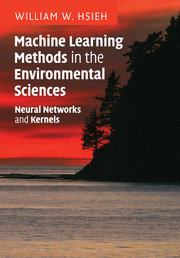Description
Machine Learning Methods in the Environmental Sciences
Neural Networks and Kernels
Author: Hsieh William W.
A graduate textbook that provides a unified treatment of machine learning methods and their applications in the environmental sciences.
Language: English
Approximative price 44.52 €
In Print (Delivery period: 14 days).
Add to cart
Machine Learning Methods in the Environmental Sciences
Publication date: 03-2018
Support: Print on demand
Publication date: 03-2018
Support: Print on demand
Approximative price 95.69 €
Subject to availability at the publisher.
Add to cart
Neural networks in the environmental sciences
Publication date: 07-2009
364 p. · 18x25.3 cm · Hardback
Publication date: 07-2009
364 p. · 18x25.3 cm · Hardback
Description
/li>Contents
/li>Biography
/li>
Machine learning methods originated from artificial intelligence and are now used in various fields in environmental sciences today. This is the first single-authored textbook providing a unified treatment of machine learning methods and their applications in the environmental sciences. Due to their powerful nonlinear modelling capability, machine learning methods today are used in satellite data processing, general circulation models(GCM), weather and climate prediction, air quality forecasting, analysis and modelling of environmental data, oceanographic and hydrological forecasting, ecological modelling, and monitoring of snow, ice and forests. The book includes end-of-chapter review questions and an appendix listing websites for downloading computer code and data sources. A resources website contains datasets for exercises, and password-protected solutions are available. The book is suitable for first-year graduate students and advanced undergraduates. It is also valuable for researchers and practitioners in environmental sciences interested in applying these new methods to their own work.
Preface; 1. Basic notions in classical data analysis; 2. Linear multivariate statistical analysis; 3. Basic time series analysis; 4. Feed-forward neural network models; 5. Nonlinear optimization; 6. Learning and generalization; 7. Kernel methods; 8. Nonlinear classification; 9. Nonlinear regression; 10. Nonlinear principal component analysis; 11. Nonlinear canonical correlation analysis; 12. Applications in environmental sciences; Appendix A. Sources for data and codes; Appendix B. Lagrange multipliers; Bibliography; Index.
William W. Hsieh is a Professor in the Department of Earth and Ocean Sciences and in the Department of Physics and Astronomy, as well as Chair of the Atmospheric Science Programme, at the University of British Columbia. He is internationally known for his pioneering work in developing and applying machine learning methods in environmental sciences. He has published over eighty peer-reviewed journal publications covering areas of climate variability, machine learning, oceanography, atmospheric science and hydrology.
© 2024 LAVOISIER S.A.S.




